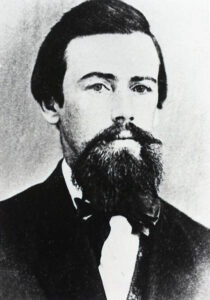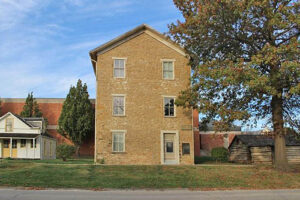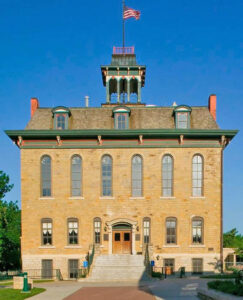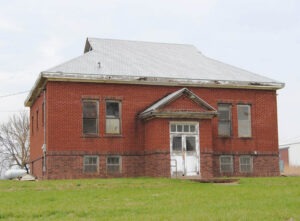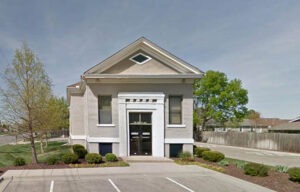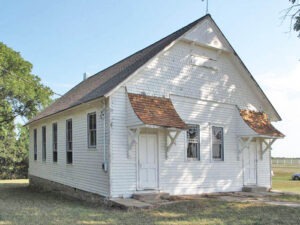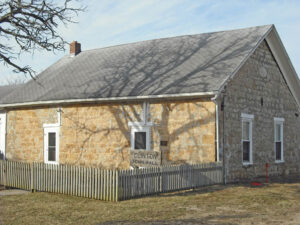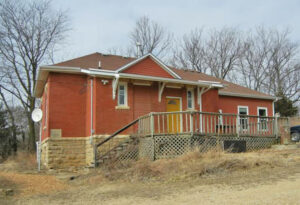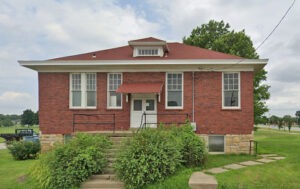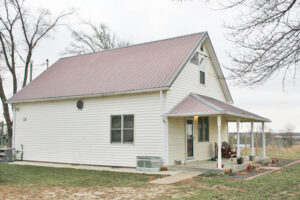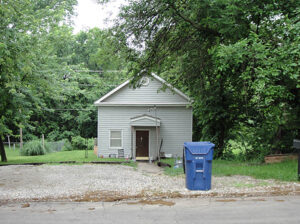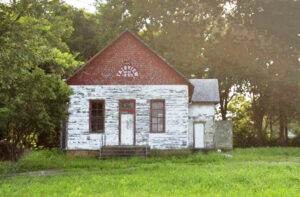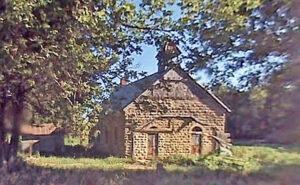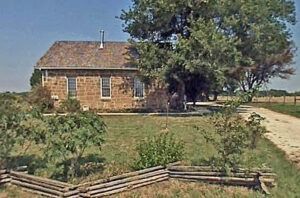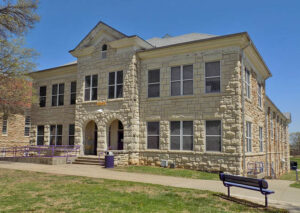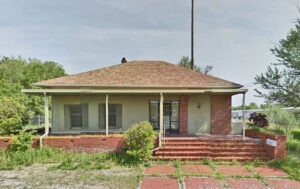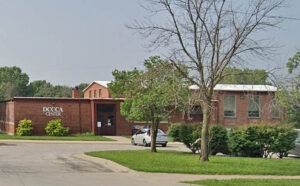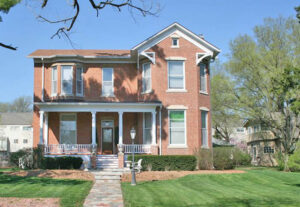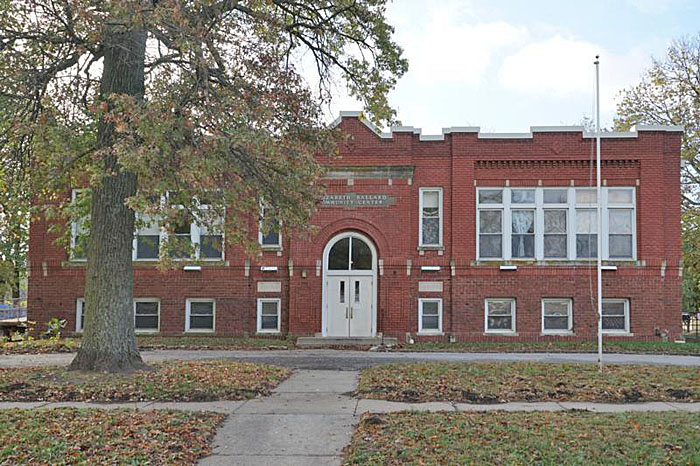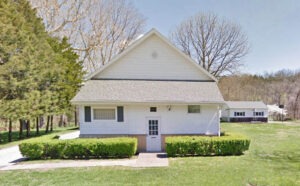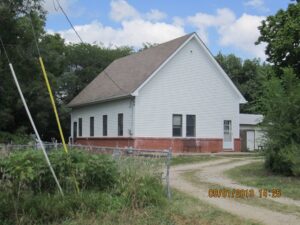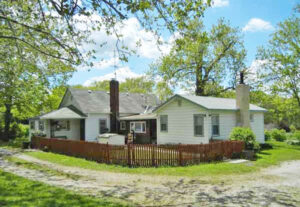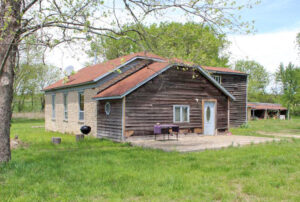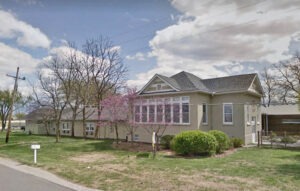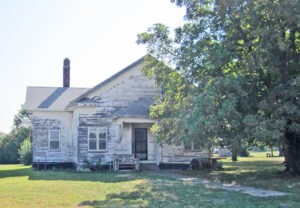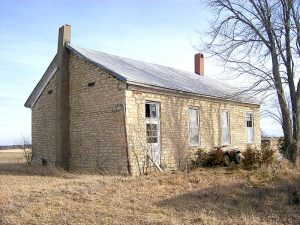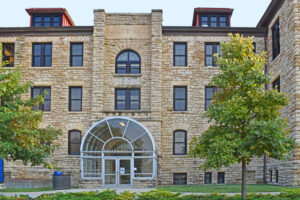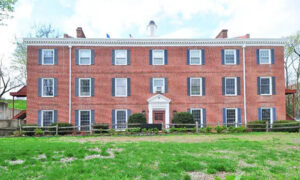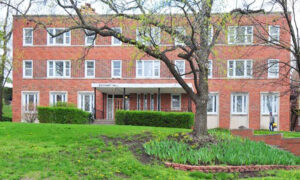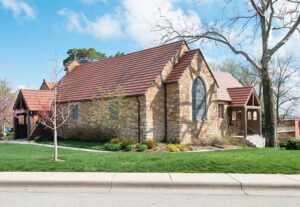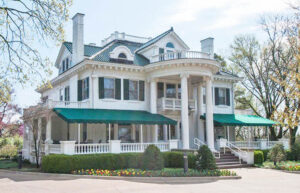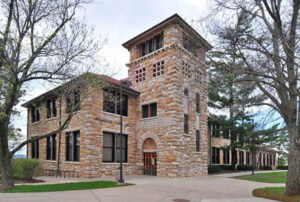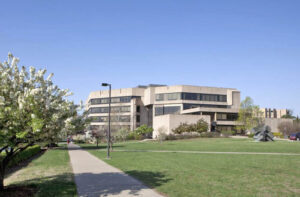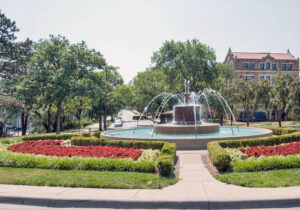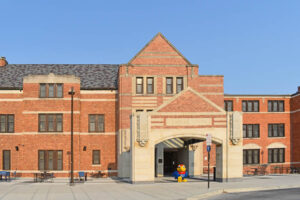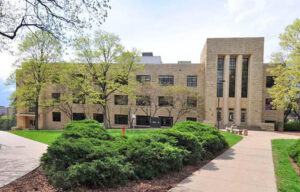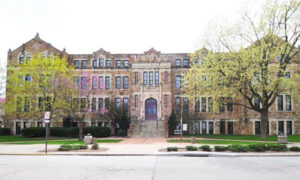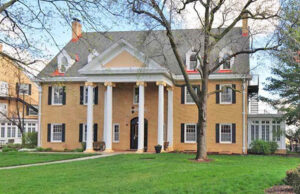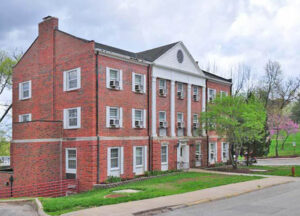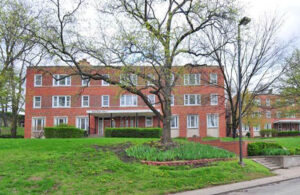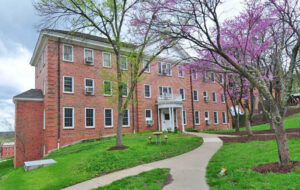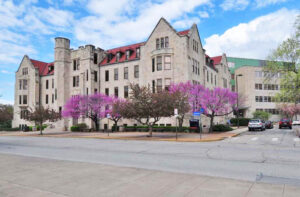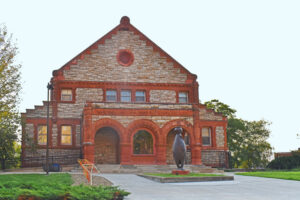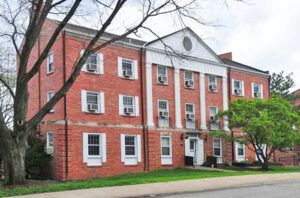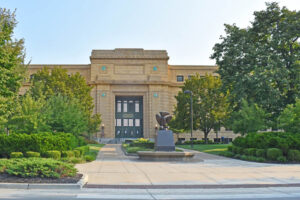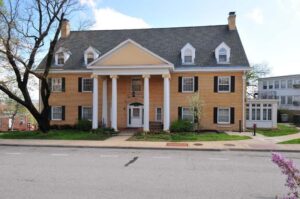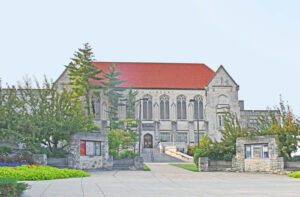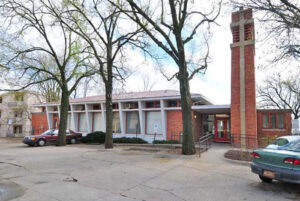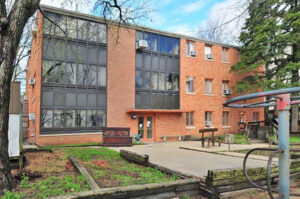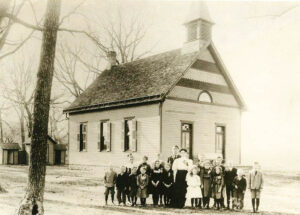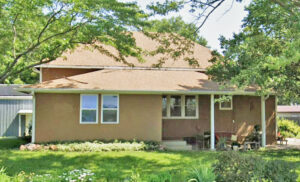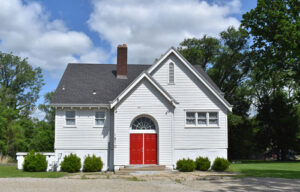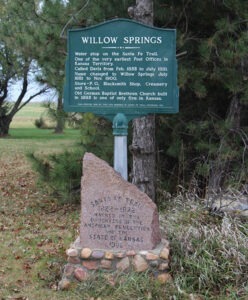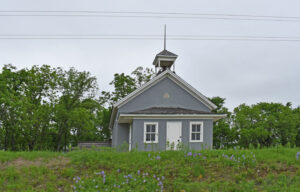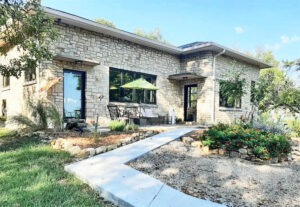“We come with the open Bible and the open spelling book. Our purpose is to place the one upon the pulpit of a free church and the other upon the desk of a free school.”
— General Samuel Pomeroy, afterward Senator Pomeroy
Douglas County, Kansas, school history began with its earliest settlement. Many of the first settlers from the New England states believed that schools and churches had much to do with developing a new state. They immediately established private schools wherever there were enough children to form classes.
The first immigrant party, comprised of 29 men, all New England Emigrant Aid Company members, arrived in Lawrence in August 1854. Though their primary mission was to ensure slavery would be illegal in Kansas, it was written into their original petition that immigrants coming to Kansas Territory would be provided with public education.
On January 16, 1855, just five months after their arrival, the first public classes were held with Edward P. Fitch of Hopkinton, Massachusetts, serving as the first teacher. There was no law by which taxes could be levied, so the citizens maintained the school by voluntary contributions. The first school district was founded in Lawrence in July 1855.
In March 1857, arrangements were made for regular and more extensive operations. Mr. C. L. Edwards was engaged in taking charge of the “Quincy High School,” named after Edmund Quincy, a benefactor of the New England Emigrant Aid Company. This school occupied the basement rooms of the Unitarian Church. A school building was constructed ten years later at 11th and Vermont Streets. By 1876, this high school was one of four university-accredited schools in the state.
In 1858, the citizens asked for a county superintendent, and Governor Samuel Medary appointed Dr. H. J. Canniff. During the winter of 1858-59, Doctor Canniff organized five school districts, the first at Prairie City.
In February 1859, C. L. Edwards was commissioned as the Douglas County Superintendent. He organized 35 school districts within three months and had 30 schools in session.
The first superintendents were paid $3 per day for their service. When the Territory became a State, they received a salary based on the population and later a fixed salary.
Many of the schoolhouses built in the early days were made of logs, and many rooms were rented for school purposes. Still, before long, enterprising citizens began to erect substantial buildings.
In 1867, a new law was passed, constituting the Board of Education. It provided for a board of six members, two from each ward. At that time, there were 11 teachers and an enrollment of 889.
The next four years may be aptly called the building era. Until the erection of the high school building, very few additions had been made to schoolroom facilities. Eight school buildings were built in North and South Lawrence during this time.
By the 1890s, many districts were supplied with all needful apparatus, and none were without aids for the teacher. Several districts took advantage of the law, which provided that a tax could be voted to secure a library, and many soon had from 25 to 125 well-selected books.
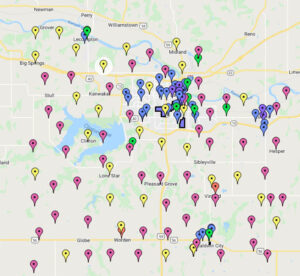
Someone took the time to map Douglas County, Kansas schools, courtesy of Google Maps.
There were 84 organized districts at that time, which required 93 teachers. The estimated value of school property was $237,570, and the average daily attendance was 4,291. With a few exceptions, most were one-room buildings that served as community centers, church meeting places, and classrooms. The county also boasted a shorthand institute, a business college, three high schools, an academy, and three universities.
The last rural school, Twin Mound No. 32, closed its doors in 1966, more than 100 years after the first school opened.
Today, numerous old and historic schools continue to stand in Douglas County.
| Name | District | Years of Operation | Location & Information |
| Adeline | 65 | 1911-1947 |
This rural school was built in 1911 on the site of an earlier school known as the Kretsinger School. The new school was built at the cost of $1,300. The original design indicated two front doors leading into a separate cloakroom, with a belfry centered at the front. The first teacher in the new facility was Edith Pearson. There were only about 14 students. By the 1920s, it had declined to ten students; in the 1930s, only three. The school closed in 1936 but reopened the following year with an enrollment of five. The school struggled to remain open in the 1940s and closed for a period but reopened for the 1942-43 term. It then closed for the following two terms and reopened in 1947. The Adeline School District was disorganized on June 4, 1949. Today, it is a residence located at the intersection of East 2300 Road and N 400 Road. |
| Baker University – Case Library | NA | 1907-Present |
This Stone building was erected in 1907. It was listed on the National Register of Historic Places in April 1986. It is located at 800 Grove Street in Baldwin City, Kansas. |
| Baker University – Old Castle Hall | NA | 1858-Present |
This rectangular three-story native stone building was built in 1858 and was a school building until 1879. Afterward, Baldwin Church held services here until 1870, and then it became the residence of President Denison of Baker University. In later years, it served various purposes, including a dining hall, dorm rooms, and storage, and today, the third floor serves as a museum. Baker University is Kansas’s oldest four-year college, chartered on February 12, 1858. It was listed on the National Register of Historic Places in February 1971. Other buildings are located on the property, including a replica log cabin [Kibbee Cabin] and the 1857 Palmyra Post Office, which was relocated to the property in 1976. It is located at 415 5th Street on the Baker University Campus in Baldwin City, Kansas. |
| Baker University – Parmenter Hall | NA |
Parmenter Hall was the second building to be constructed at Baker University, after Castle Hall. Also known as Parmenter Memorial Hall, the building was constructed from 1865 to 1871. The building’s claim to fame is that President Abraham Lincoln donated $100 toward its construction, allegedly the only donation Lincoln made. Though its cornerstone was laid in June 1866, it would take several years due to a lack of funds. By 1871, the building had been enclosed, and in March, the students and faculty left Old Castle Hall for the new facility. The French Empire style influenced the two-and-one-half-story native stone building with a full basement. Only the first story was ready for use, a condition that continued for about ten years. By the 1880s, full utilization of the building was available, and enrollment for the college increased. In 1882, a tower and belfry were placed on the building, and a large bell was installed, a gift of the community’s citizens. Another building was begun in 1884 as enrollment increased to 350. The uses of this building and the names applied to it changed over the years. For about 15 years, it was the college building. Later, it was the Science Hall and then the Old Science Hall. In 1938, it was remodeled and then named Parmenter Hall after Charles S. Parmenter, a long-time professor of biology and university administrator. Uses have included administrative offices, a gymnasium, a theater, a museum, classrooms, laboratories, and music rooms. Parmenter Hall now houses the Holt-Russell Gallery on its second floor, featuring student art. It hosts an annual juried art show for students. The Darby-Hope Theater is on the third floor, named after comedian Bob Hope and U.S. Senator Harry Darb. The uppermost level, beneath the mansard roof, is called “Parmenter Loft” and contains some art department spaces. It was listed on the National Register of Historic Places in September 1977. It is located at 706 Dearborn Street in Baldwin City, Kansas. |
|
| Baldwin High School | 41 | 1923-2011 |
Bonds for the first Baldwin City high school were approved in 1887. The south half of the block where the present building is located was purchased in 1888, and a brick building was constructed. The north half of the block was acquired in 1904. Another bond issue for a new public school was approved in 1921. The building was occupied early in 1923. A modern addition was constructed in 1956. A new high school was built in 1968 in the northeast part of the city, and this building became a junior high school. This Progressive Era three-story T-shaped school was designed in a Commercial style with two side entrances and end blocks. It has two stories, a raised basement, nine central bays and four bays in each end block, brick masonry construction, and a flat roof with a shaped parapet. Ornamental features include segmental-arched basement lintels, round arch brick entrance openings, circular eave medallions in the end blocks and central niches, corbeled brick eave detailing, gabled parapet with stone cap, end blocks, and central raised gable sections. It was initially a U-shaped plan with a centrally located two-story gym. In 1942, the two-story gym space changed use and had an intermediate floor partially installed and completely installed in 1969. It hosted both elementary and high school classes until a new high school was built in 1969. The original primary stairways are intact, with doors added to create enclosed stair shafts in 1969 and 1987. Classroom spaces are generally in their original locations, with some modifications of partition walls for subdivisions in various configurations. It was listed on the National Register of Historic Places In May 2015 as part of the Historic Public Schools of Kansas & New Deal-era Resources of Kansas multiple property nominations. The old high school is at 704 Chapel Street in Baldwin City, Kansas. Today, the building serves as Courthouse Lofts Apartments. |
| Barber | 82 | 1872-1946 |
Located in Kanwaka Township, the land was deeded for the school in October 1871. It is located within the Clinton Reservoir Recreation Development of Douglas County and was constructed in 1871-72 by Solomon B. Geary, builder, for $600. The walls are constructed of roughly dressed yellow/brown limestone, while the cornerstones and sills are of light grey limestone. The schoolhouse was named for Thomas Barber, one of the first anti-slavery martyrs in Kansas. There was a record of 21 students attending school there in 1898. The school remained in operation until 1946 when only two students attended. |
| Big Springs | 72 | 1926-1963 |
The Big Springs School was created when eligible voters met at the Pickens Hotel in 1869 and voted for a school tax. Students were first taught in a local church. In 1878, the district bought two acres of land and built a frame building. The building’s front door opened directly into the schoolroom. Against the wall were benches on which dinner buckets rested, with space underneath for overshoes and hooks in the wall above for coats and hats. The far wall, which held the teacher’s desk and an organ, was one step high. In 1926, the school was replaced by a one-room brick and stone building just east of the town’s business section at the cost of $7,000. It had a basement used for a lunchroom and some play. In 1932, it became famous for having the largest number of students in a one-teacher school in Kansas. The teacher, Mrs. Mildred Brown, had 53 students. In 1949, the room was converted into two rooms, and two teachers were hired. In the late 1950s, schools and districts began to be consolidated. Big Springs School was terminated in 1963 and united with the Shawnee Heights school district in Tecumseh. |
| Brackett | 54 | 1916-1963 |
In April 1865, a one-acre tract of land was deeded to School District No. 54 by Henry T. and Elisa D. Davis. The school was named after George Brackett, the first director of the school board. Two buildings preceded this all-brick building that remains today. The Brackett School District was disorganized in March 1963 when it was consolidated with Riverside School District No. 53. The building now serves the Lawrence Board of Realtors at 3838 W 6th St in Lawrence. |
| Burnett | 62 | 1916-1962 |
This wood-frame building was constructed in 1916. Consolidation talks began in 1958. In the fall of 1962, Burnett, along with White School Dist. 61, Oak Ridge School Dist. 63 and Bismark Dist. No. 79 consolidated to form Grant School District No. 100. This school building still stands at its original location at Midland Junction in northern Douglas County. It is located at E County Road 1400 and U.S. Highway 59. |
| Clearfield | 58 | 1900-1946 |
Baldwin City. German settlers established the Clearfield School District in Palmyra Township in 1852. It is the second oldest school district in Kansas. Soon, a log structure was built, and students were taught in German. In 1900, the Clearfield School was built northeast of Baldwin City, replacing the earlier log structure. It was initially built at a location one mile east but was moved to its current location in 1908. The school closed in 1946, but it continued to serve as a meeting house for the Clearfield Grange until it disbanded in 1991. Today, the building is on the National Register of Historic Places. The site also includes two outhouses and a shed. It is located at 2162 North 600 Road. |
| Clinton | 25 | 1866-1885 |
In May 1866, the school district recorded a deed, and this schoolhouse was built. In 1884, the school was supposedly condemned, and a new frame structure was built in 1885. The old stone school building was then advertised and sold for $150.00. It was then utilized for several years as the telephone office. In 1930, the building was sold, and after passing through a couple of hands, the Clinton Township Board of Directors bought it for $250.00. It then became known as the Clinton Town Hall. It continues to serve as a community meeting place for various organizations and has become the “culture center” for activities in the Clinton Lake Area. The old school is at 1177 E 604 Rd, Lawrence, Kansas. |
| Colyer | 42 | 1979-1962 |
The Colyer School was constructed of wood frame in 1879 for $1000. During the 1940s, the school was closed for five years due to low enrollment, and students were sent to nearby Lone Star School. It was reopened in 1949 with nine students. In 1962, the school closed with ten students. At that time, the district was consolidated with Marion Springs District No. 101. In 1963, the building was sold at auction. It still stands on the southwest corner of the intersection of N. 600 Road and E. 800 Road. |
| Crowder | 69 | 1905-1956 |
The first Crowder School was a log cabin structure built on a one-acre tract in 1870. Because of its location on a lonely rocky slope of a hill, it became known as “Stony Lonesome.” During the 1897-98 term, there were 22 students enrolled. During the first decade of the 20th century, the school became too small for the area population, and a larger brick building was constructed to the east of the original location. The last school term taught at the Crowder school was 1955-56. Only five students were enrolled at that time. The school district was then disorganized and absorbed into the Lecompton School District. Afterward, the building was converted into a private home. It is located at 948 N 1950 Road, Lawrence, Kansas. |
| Crutchfield/No.6 | 06 | 1924-1959 |
This school, located at the intersection of Clinton Parkway/23rd Street and Iowa Street in Lawrence, Kansas, was once located in the country and was known by most as No. 6. At that time, it was about two miles west of Lawrence’s city limits. The first building on the site was a log cabin school. Later, a wooden frame building with two front doors was erected. It would seat 48 students. This building was demolished in 1924 to facilitate the construction of today’s brick structure. Crutchfield No. 6 was consolidated with other county schools in 1959 to form the new school of Wakarusa Valley School District No. 98. This facility is now the property of Kansas University. |
| Douglas County | ?? | 1887-?? |
This one-and-a-half-story rectangular school was designed in the National Folk style with a gable-front roof. The house has a rough-faced concrete block foundation, synthetic siding, replacement windows, and a metal roof. Serving as a residence today, it is located in Marion Township in the Overbrook vicinity of Douglas County, Kansas.
|
| Eudora | 1860 |
This one-room school was initially located at 6th and Main Street in Eudora, Kansas. This one-story gable-front building is three bays wide and three bays deep. A replacement portico shelters the entrance. It has a shed addition in the rear. The building is now clad in synthetic siding. It didn’t serve long as a school as it was converted to the City Hall in 1866. It was relocated to its present location in 1955. Today, it is a small dwelling located at 731 Maple Street in Eudora, Kansas. |
|
| Fairview | 21 | 1890 |
Omar Ayer donated the tract on which this school was built. The first school building was constructed in 1869. The present building was constructed in 1890. The new building became a community center where various meetings were held. Sunday school was one of the first events, but political meetings, literary society meetings, and spelling bees were also held in the school. Later, the local Grange Lodge met in the schoolhouse. In 1961, after one year on a tuition basis, the Fairview school closed, and the district was disorganized and attached to Kaw Valley District #95. This wood-frame Folk Victorian-style rectangular building is located at 1055 E 1500 Road, about three miles south of Lawrence. |
| Franklin | 16 | 1873-?? |
The old Franklin School is located at 1715 N 1360 Road D. |
| Glenn | 33 | 1890-1948 |
The Glenn School, built in about 1890, replaced a small frame structure built in 1879. This school was constructed by Chris Christenson, a Swedish stonemason of native limestone, with three shuttered windows on the side. This school was always very well equipped and could pay the teachers an above-average salary due to the taxes paid by the nearby railroad. The one-acre site soon proved too small for the student baseball players, and A.G. and Elizabeth Glenn deeded one-quarter acres of land on the west and north sides to allow for an adequate-sized ball field. It wasn’t long before the ballplayers had outgrown this space, and Cyrus and Josephine Glenn deeded another 1.85 acres, extending the north and west property lines to include a little over four acres. This land was deeded in 1922. Glenn School saw many changes through the years. A front enclosed entry was added, and a basement was excavated in 1916 to facilitate the addition of a coal-fired furnace and store coal. A cistern was added about the same time. There were 52 students for the 1897-98 term. The term of 1929-30 had an enrollment of 28 students. The school was closed for the terms of 1940-41, 1942-43, and 1943-44, when students were sent to Lecompton. Glenn School was reopened for the term of 1944-45 with Jessie Winter teaching. The school was consolidated into Lecompton in 1948, and the district was disorganized. Afterward, the building was given to a group to be used as the Methodist Church. However, they did not use the building, which sat vacant for several years. Glenn School was finally sold and converted to a private residence. It is located at 342 N. 2100 Road, two miles west of Lecompton, Kansas. |
| Greenwood Valley | 24 | 1896-1960 |
|
| Harmony | 57 | 1871-1947 |
The site was established as a school on March 29, 1871. The materials for this native sandstone building were quarried from the surrounding hills. Initially, two doors were entering the one-room. Early teachers were Alice Reed in 1894-95, George Nichols in 1895-96, and Alvin Crouch 1896-97. For the term of 1897-98, A. H. King taught 54 students. The following year, he became the county superintendent. Faye Hagerman Deay taught 19 students in 1940 and continued teaching here until 1947 when the school was disorganized. The last term of school only had an enrollment of six students. On April 28, 1947, Harmony School District No. 57 consolidated with Vinland School District No. 88. The building remains and has been converted into a residence.1954 N. 800 Road. |
| Haskell Indian Nations University | NA | 1884-Present |
Haskell Indian Nations University is a public tribal university in Lawrence, Kansas. From its beginning as a government-run residential boarding school for Native American children in 1884 to a fully accredited university today, it has successfully evolved into a university for Native students emphasizing Native culture, sovereignty, and self-determination. |
| India | 55 | 1920-1965 |
The original location for India School No. 55 was at 506 East 23rd Street Frontage Road in Lawrence. In about 1920, a second building was built on the same site. This one-story brick structure was smaller than the previous building but had a basement. The main floor included a small library and had a folding partition, which could be used to divide the room in case two rooms were required. In 1951, Walnut Grove School District No. 11 was added to District No. 55, increasing the enrollment of India School. In 1956, the school board determined that the second building had become too small. School bonds were passed to build a new school farther east at 1739 East 23rd Street. This new brick structure had three classrooms and a small gymnasium with an elevated stage. Soon, this new facility became too small, and one class was held on the elevated stage for a year. India School District No. 55 was consolidated with the Lawrence Unified School District No. 497 in 1965. At that time, the district still used India to teach kindergarten through third grade, sending the upper grades to the old Kaw Valley No. 12. This building still serves the community as the Douglas County Citizens Committee on Alcoholism Outpatient Services Center. It is located at 1739 E 23rd St, Lawrence, Kansas. |
| Lane School | ?? | 1873-?? |
This two-story Folk Victorian-style school was converted from a school to a residence in 1904 when it was sold to Henry C. Riggs. Riggs made many renovations, including adding a bay window, a porch, and a back addition. There is a garage/carriage house in the rear with alley access. It is located at 907 Arkansas Street in Lawrence, Kansas. |
| Lecompton High School | 4 | 1927-1970 |
Lane University was built in Lecompton right after the Civil War. When Lane University closed in 1902, the Lane University building offered a three-year high school course. Two years later, a regular four-year course was offered. In 1927, a new high school was built just south of Lane University at approximately $65,000. The building contained seven classrooms and a state-of-the-art theatre and auditorium. A tennis court was a little northwest of the building, and a football field was directly north. In the 1950s, a larger gymnasium was added to the north side of the school. Owls were the school mascot, with school colors of black and gold. A total of 793 students graduated from the Lecompton High School. The students of the class of 1970 were the last to graduate. The following year, Lecompton High School merged with Perry High School, creating Perry-Lecompton High School. Today, the old Lecompton High School building serves as a community center for theatrical programs, a library, classes, and community events. |
| Lincoln Public School | ?? | 1915 |
The old Lincoln School was one of the first substantial schools to be established in North Lawrence. This building is a later iteration, which was built in 1915. The old school site is currently part of Lyons Park. The one-and-a-half-story red brick building was designed in a Commercial/Neoclassical style. By 1965, the structure was donated to Ballard Community Center as a nursery school. Elizabeth Ballard Community Center is a non-profit institution that provides affordable, high-quality early education for young children (1-6 years old). (Kindergarten). It is located at 708 Elm Street in Lawrence, Kansas. |
| Lone Star | 47 | 1896-1959 |
After a previous school building proved too small, a new school was built in the fall/winter of 1895-96. By 1898, it had an enrollment of 58 students taught by J.W. Gowans. This building served the district for over 50 years and saw many changes. A roof was added to the front porch, a belfry was added, a basement was constructed beneath the building with an exterior entrance, a new double-door entrance was made on the front, and much new playground equipment was added. A well was drilled in 1932. Colyer District No. 42 students were added in 1944, and Apple Pie District No. 27 in 1946. The last term for Lone Star was 1958-59, when it was consolidated with several other Douglas County rural schools to form Wakarusa Valley District No. 98. Afterward, the building was sold at auction and converted into a private residence. It is located at 880 E 800 Rd. |
| Marion Springs Elementary | 101 | 1963-2011 |
The consolidated Marion Springs School District No. 101 combined students from six one-room schoolhouses. A special bond election held in August 1962 raised $185,000 for the construction of the building in 1963. The new school opened in August 1963. The school transitioned local education from one-room schoolhouses to a graded system. During the first year of operation, teachers taught combined classes for grades one and two, three and four, five and six, seventh and eighth. The school also employed a custodian and two lunchroom employees that year. In 1966, the Marion Springs School District was attached to the Unified District #348 of Baldwin. The school’s population grew but decreased the grades. In the 1980s, grades taught included kindergarten through fifth. A bond election in 1993 added new windows, south resource rooms for technology, and a library. The school’s last year was the 2010-2011 school year. The od rectangular brick Marion Springs Elementary School retains most of its original exterior appearance and interior layout. The north portion of the building contains the over-height gymnasium. The one-story south portion contains the entrance, two offices, the kitchen, two bathrooms, and six classrooms. It has a metal flat roof. Located at 316 East 900 Road near Baldwin City, it now serves as a single-family home and event space, |
| Model | 83 | ??-1947 |
This frame structure was built on this site in 1895. Behind the school was a large pond, where residents often gathered to ice skate in the winter. Like most rural schools, it also served as the community’s social center. Teaching the 1897-98 term was Ed Shepp, with 35 students. In 1922, a basement was dug under the building to facilitate a furnace. The school was closed for the terms of 1947-48 and 1948-49. An agreement was made with Crutchfield No. 6 to accept the students from Model temporarily during this time. Model District No. 83 consolidated with Pleasant Valley District No. 14 in 1948. Afterward, the school building was sold and has since served as a residence. The building is located southwest of Lawrence, on Douglas County N 1000 Road, about two miles west of Highway 59 on the north side of the road. |
| Oak Grove | 10 | 1870-1958 |
This school was first named Dyer after John Dyer, who supported education in the district, served on the board, and loaned money to the district. The school became Oak Grove, then Oakdale. The school was expanded in about 1906 with a full East porch, a belfry, and an interior stage, both removed today. The porch was later enclosed, forming anterooms and a kitchen. A new ell and brick chimney were later built on the north side. A modern room is connected to the later ell. The last school term was in 1958. On June 3, 1960, the district was disorganized and annexed to Baldwin District No. 92. The one-story Vernacular-style building with a gable-front roof serves as a residence today. It is located at 102 East 1300 Road in the Baldwin City vicinity. |
| Oak Ridge | 63 | 1933-1961 |
The founding of School District No. 63 began with J.F. Morgan and Governor Charles Robinson. Shortly after J.F. Morgan moved to this area, he established a subscription school in 1866, to which the families paid $8.00 per student to attend. Augusta Hunt taught the first term of 12 students. District No. 63 was officially organized in April 1867, with J.F. Morgan as director, E.W. Morgan as clerk, and Dr. Charles Robinson as treasurer. The district’s first building was leased from Charles Robinson, and his niece, Emily Robinson, was the teacher. A native stone structure was built on the Morgan property in the fall of 1870. In the early days, the building was known as “Robinson School.” However, Mrs. Robinson later began calling it “Oak Ridge,” which is also their estate’s name. During the early years, the district enrolled 50-60 students. At the close of the century, Winnie Reno taught 27 students. The first native stone building served the district for 46 years. It was replaced in 1917 by a second native stone structure with Emma Hartley as the first teacher. Twenty-six students were enrolled in 1920. At the end of the decade, enrollment was 17. In January 1933, the school burned down, and classes were then held in the former Robinson home. The following school was built of brick and was dedicated in August 1933. At the end of the decade, there were 16 students enrolled. In 1961, the school consolidated with White District No. 61, Bismarck District No. 79, and Burnett District No. 62 to form Grant District No. 100. The school was sold at auction in July 1962 and became a private residence. It continues to stand at 1924 E 1600 Rd, about five miles northeast of Lawrence. |
| Old Belvoir | 26 | 1866 |
In August 1865, a permanent school site containing five acres about a half mile southwest of Douglas County Rt was planned. 458 on the northwest side of Douglas County Rt. 1023. The rock structure built on this site was about 20 feet by 40 feet. The school was initially called Bailey after the original land owner. Early teachers were W. Markle and George Hubbard. It was later called “Old Belvoir” when Belvoir No. 84 was established. The school was absorbed into Clinton School District No. 90, which was then changed to District No. 94. This building served as a community building for a short time and then was sold and converted to a private residence with several additions, which still stands today. The original two-story Vernacular-style stone school building is oriented to the Southeast. The stone portion has a front-clipped gable. A modern frame entrance with a clipped gable has been added to the southeast façade and a modern frame two-story addition project from the northeast elevation. Frame additions are clad in wide wood boards. The building is a residence today. It is located at 356 N 851 Diag Road in Clinton, Kansas. |
| Pleasant Valley | 14 | ??-1959 |
Pleasant Valley School District had several buildings over the years. This building is the fourth to be used as a school at this location. This more modern stucco structure contained two classrooms. In 1948, Model No. 83 joined with Pleasant Valley to form the New Pleasant Valley District No. 14. In 1959, Pleasant Valley No. 14 became part of Wakarusa Valley No. 98. Today, this building serves the Unitarian Universalist Congregation of Lawrence. It is located at 1263 N 1100 Rd, about three-quarters of a mile west of Highway 59, south of Lawrence. |
| Prairie City | 87 | 1903- |
It was agreed upon by the New Prairie School District No. 87 to build a new building at a new location in 1903. Robert Miller sold one acre of land on the southeast corner of E. 1550 Rd. and N. 150 Rd. for the building’s construction. Prairie City No. 87, the first rural school district in Douglas County, consolidated with Baldwin City District No. 92. |
| Rock Creek | 13 | ??-1945 |
Rock Creek School was a native stone building approximately 15’x17′. It was built with a center door on the west end and two windows on the north and south sides. A rock chimney was located in the center of the building. Though the small building still exists, it is not recognizable today. It has been enlarged, covered with modern siding, and converted into a private residence. It is a half-mile east of E. 300 Rd. on N. 750 Rd. |
| Twin Mound | 32 | 1880-1966 |
In 1865, a school board was elected, and a small one-room structure was built. The first structure served until about 1880, when it was replaced by a much more substantial stone building that still stands today. The final year for the Twin Mound School was 1966, with an enrollment of only seven students. The school is considered the last rural Douglas County school to consolidate. It was owned by the Twin Mound Grange from 1966 to 1998. Since then, the building has been in disuse. The school, along with its log school predecessor, was in continuous operation for over 100 years and dates from the first decade of the community’s settlement in the late 1850s. |
| University of Kansas – Bailey Hall | NA | 1900-Present |
Bailey Hall, the Chemistry Building at the University of Kansas, was erected between 1899 and 1900 to replace an older, much smaller chemistry building erected in 1883 that was near the site of the new building. The location on Mt. Oread was ideal because its limestone base provided a strong fountain for the new chemistry building and was near local limestone quarries. In a modified H-shape plan, the massive, load-baring masonry building consists of four stories, including a basement, and measures 187 feet in length and 70 feet in width at its broadest point. Except for a few changes, Bailey stands today much as it did when it was completed in 1900. It is located on the northwest corner of Jayhawk Drive and Sunflower, with its front elevation facing south onto Jayhawk Drive. |
| University of Kansas – Battenfeld Scholarship Hall | NA | 1940-Present |
This three-story T-shaped brick building was designed in the Colonial-Revival style, with stepped gabled parapets and interior chimneys capping the gabled roof. The symmetrical front (east) facade has seven bays, each containing a single window flanked with fixed shutters. A shallow eave articulated with dentils encircles the building. The center entry has a single-paneled door with a simple pedimented surround. A small cupola rises from the center of the roof ridge. The student residence/dormitory was the first men’s residence hall on campus. The surrounding area consisted of private residences, single-family homes converted to student residences, or scholarship halls for women. The building was a gift from Mr. and Mrs. J.R. Battenfield and named for their son, John Curry Battenfield, who died in 1939. It was listed on the National Register of Historic Places as part of the University of Kansas East Historic District in January 2014. It is located at 1425 Alumni Plaza in Lawrence, Kansas. |
| University of Kansas – Douthart Scholarship Hall | NA | 1954-Present |
Douthart Scholarship Hall was constructed as a scholarship hall for 48 women in 1954. State Architect Raymond Coolidge designed the building to have bedroom/study area suites for residents. The building, funded by a significant gift from Burt Chronister, is named in honor of alumnae Ava Douthart Chronister and her sister Lela Douthart. This three-story rectangular red brick building with stone trim on the front elevation was designed with a flat roof in the Modern/Modern Movement style. The long front (east) elevation is divided into nine bays. The center of the first story contains a wide porch with metal posts supporting a flat roof. The facade has a wide single entry with flanking single-pane sidelights and transoms. The second and third stories contain three groups of double-hung windows flanking a Chicago-style window. The building remains in use as a scholarship hall for women. It was listed on the National Register of Historic Places in January 2014 as part of the University of Kansas East Historic District. It is located at 1345 Louisiana Street in Lawrence, Kansas. |
| University of Kansas – Dyche Hall | NA | 1902-Present |
Dyche Hall on the University of Kansas campus is the Museum of Natural History. The four-story building with a full basement was built in a Romanesque style of rough-hewn limestone in 1901-1902. From its conception, the building was intended to house the nationally renowned collections of Lewis Lindsay Dyche, Professor of Taxidermy. Dyche enrolled at the University of Kansas in 1877 and joined the teaching staff after graduation. An avid outdoorsman, he made numerous trips to the Rocky Mountain region, where he obtained many specimens to enlarge the university’s collection. More than 100 of his mounted animals were displayed in the Kansas exhibit at the Chicago World’s Fair in 1893. His work was widely acclaimed because of the natural, lifelike stances of the mammals. Altogether, he made 23 expeditions in the interest of the university museum. Dyche was regarded as one of the nation’s leading hunters, explorers, naturalists, taxidermists, and lecturers. The museum was first used in October 1902 while still under construction. It housed classrooms and laboratories but was mainly the home of Dyche’s growing wildlife collection. Following the death of Professor Dyche in 1915, the building was officially named Dyche Museum. An addition was built to the north in 1963 to provide more classroom space. Dyche Hall was listed on the National Register of Historic Places in July 1974. Dyche Hall is regarded as one of the most distinctive buildings on the university campus. It forms a small core of architectural tradition on the campus with nearby Green Hall and Spooner Hall. It is located at 14th St. and Oread Avenue in Lawrence, Kansas. |
| University of Kansas – East Historic District | NA | 1912-Present |
The University of Kansas East Historic District encompasses roughly 13 acres on the east side of the campus, about one-mile southwest of the civic and commercial center of Lawrence, Kansas. The long, narrow district is bounded by Oread Avenue, Jayhawk Boulevard, and Lilac Lane on the west; Sunnyside Avenue on the south; Pearson Place and Louisiana Street on the east; and west 13th Street on the north. The west boundary of the district follows the east boundary of the adjacent University of Kansas Historic District. The evolution of the residential, religious, and student-life facilities associated with the university campus over a century is evident in the variety of architectural styles and functional property types present in the District. The long, linear district contains 15 buildings and three objects on roughly three blocks. All 15 of the contributing resources were constructed between 1912 and 1963 and reflect several of the high-style residential architectural styles popular at the time of construction. The three non-contributing resources were constructed outside the period of significance. The District clearly represents the historic functions of the buildings concentrated in an area designed to provide residential and cultural facilities to support the primary academic functions of the University. It was listed on the National Register of Historic Places in January 2014. |
| University of Kansas – Fowler Shops (Old) | NA | 1898-Present |
The Old Fowler Shops were constructed in 1898 with a donation from Kansas City meat packer and rancher George A. Fowler. The building was designed to house the engineering department and state-of-the-art equipment. The engineering department moved to the New Fowler Shops when they were constructed in 1949. The School of Journalism moved to the vacant building in 1952. The building was renamed Stauffer-Flint Hall in 1982 after Topeka’s Oscar Stauffer, who donated $1 million to renovate the building, and long-time School of Journalism professor and department chair Leon N. Flint. The two-story L-shaped building was designed in the Richardsonian Romanesque/Romanesque Revival style with rubble limestone walls and a complex hipped roof clad in red shingles. The building consists of two rectangular blocks. The long, two-story east block has a four-story tower attached towards the east end of the front (north) elevation. The tower has round-arched openings on the lower two stories, stone grilles on the third story, and tripartite windows on the fourth story. The main entrance on the east side of the tower has a stone lintel topped with a blind arch. The one-story west block is offset slightly from the east block and has two shed dormers rising from th north and south roof slopes. The west block has round-arched openings with stone voussoirs and sills. The building was remodeled in 1952 and 1981. It presently functions as the William Allen White School of Journalism, classrooms/offices. It was listed on the National Register of Historic Places in April 2013 as part of the University of Kansas Historic District. It is located at 1435 Jayhawk Boulevard in Lawrence, Kansas. |
| University of Kansas – Green Hall | NA | 1905-Present |
Green Hall is the home of the University of Kansas Law School. The exterior is essentially an example of a 19th-century application of the Neoclassical style of architecture. The exterior material was different from any other material used on the campus at the time of construction. Green Hall was erected in 1904-05 to house the School of Law, which had been established in August 1878. The first head of the law department, and for a time the only instructor, was a 33-year-old Lawre ce lawyer, James Woods Green. He received no salary from the university but was permitted to collect $25.00 from each of the 13 hopefuls who enrolled in the first classes. In the 1879 university catalog, he was listed as the “Dean” of the law department. For 25 years, the law classes met where space was available. Finally, the legislature authorized the construction of a law school building. The new facility was completed by September 1905 for $65,000 and was officially dedicated on November 3 as Green Hall, named in honor of the law school’s first dean. Dean Green, affectionately known as “Uncle Jimmy” by generations of students, delivered the main address at the dedicatory service. A seven-story stack library addition was built onto Green Hall. The new addition sits in the rear of the building and is connected only by a covered walkway on the second and third floors of the building. It is located in the center of the campus at 1535 W. 15th Street. |
| University of Kansas – Historic District | NA | 1878-Present |
The University of Kansas Historic District and its 52 resources occupy 85 acres flanking Jayhawk Boulevard at the heart of the campus, about one mile Southeast of the civic and commercial center of Lawrence. The University of Kansas was established in 1864 to provide higher education opportunities in Kansas, focusing on literature, arts, and sciences. The campus was developed on land donated by former Kan as Governor Charles Robinson. The buildings, structures, sites, and objects within the district were constructed between 1878 and 2008 and reflect the primary academic core of the university campus that evolved along Jayhawk Boulevard. The evolution of the campus is evident in the variety of architectural styles and landscape design trends present in the district. It was listed on the National Register of Historic Places in April 2013. |
| University of Kansas – Kansas Union | NA | 1927-Present |
The site for the building was selected in 1924, and the groundbreaking took place at the time of commencement in 1925. The cornerstone was laid on April 30, 1926, and the cafeteria area began service in September 1927. The original portion of the structure wasn’t completed until 1939, the last being the Kansas Room. Hard-earned Depression-era dollars were solicited from students, alumni, and friends of the University under the promise the building would be a lasting Memorial to KU students and alumni who gave their lives in World War I. It presently functions as the student union. This seven-story rectangular red brick building was designed in the Collegiate Gothic style with a flat roof. It is composed of multiple rectangular blocks of varying heights, creating an irregular mass, particularly on the west elevation. The asymmetrical front (east) facade has three primary blocks, with the center block projecting forward while the flanking blocks are set back. Stone or cast stone belt courses run the length of the facade below the windows at each story, across the three blocks, unifying the facade. The center block vaguely conveys the Collegiate Gothic style with parapet on gable slate roofs. The flanking blocks have simple facades ornamented only with engaged pendants carved in low relief, communicating elements of the Art Deco style. The rear (west) elevation continues using stone or cast stone beltcourses to define stories. Additions were constructed in 1952 and 1961 and renovated in the 1980s. This building stands within the boundaries of the University of Kansas Historic District but is non-contributing due to a lack of integrity due to extensive exterior and interior alterations. It is located at 1301 Jayhawk Boulevard in Lawrence, Kansas. |
| University of Kansas – Lindley Hall | NA | 1943-Present |
The building was designed to house the mineral resources departments of geography, geology, chemical and petroleum engineering, mining, and metallurgical engineering. Built to house the Department of Geology and the State Geological Survey, it was originally called the Mineral Resources Building. The Legislature voted funds for its construction in the spring of 1941, and work on it was started later that year. However, World War II brought government restrictions on many items, particularly steel, and it appeared that the completion of the building might be delayed indefinitely. Just when prospects seemed dimmest, a resourceful member of the faculty, believed to have been Dean J. J. Jakosky of the School of Engineering, came up with an idea. The proper officials in Washington D.C. were contacted and promised that if the building could be completed, it would be available for use in furthering the war effort. The necessary priorities were made available, particularly for obtaining steel, and the structure was completed, at least partly, during the summer of 1943. Its first occupants were 250 young men in the Army A-12 program. It presently contains classrooms and offices. This four-story L-shaped stone building designed in the Streamlined/Art Moderne style has dressed limestone walls and a flat roof. It has a long front (east) elevation and a shorter wing projecting westward from the north end of the rear (west) elevation. The southernmost bay and the wide second bay from the north end contain the building entrances. The north bay is a block that projects outward from the primary facade and rises above the roof line as well. This wide bay contains a ta l, recessed rectangular area. This area contains three-story engaged columns separating the three long vertical bands of multi-light windows. Below these vertical windows are three single doors that comprise the main entrance. Each door is topped with a stone panel carved in low relief, designed and carved by Bernard “Poco” Frazier. The rear elevations have irregular bays containing a single window opening at each story. It was placed on the National Register of Historic Places in April 2013 as part of the University of Kansas Historic District. It is located at 1475 Jayhawk Boulevard in Lawrence, Kansas. |
| University of Kansas – Marvin Hall | NA | 1908- |
In the fall of 1907, work got underway on a building for the School of Engineering. It was to be located at the extreme western edge of the campus to provide room for the laboratory, which would eventually be built in the back of it. It was completed by the fall of 1908, at which time enrollment had reached 2,000. However, it could not be used since there was no way to heat it. The old heating plant had been taxed to its limits by the erection of the old Robinson building. Marvin Hall had to wait until a new heating plant could be completed in the spring of 1909. The building was named after Frank O. Marvin, the Dean of the School. The building was remodeled in 1981, and Gould Evans won the Kansas City Missouri AIA Award for Design Renovation in 1982. This four-story L-shaped limestone building designed in the Gothic Revival style has a cross-gable roof with flat and peaked parapets. The building has a shallow wing that projects southward from the east end of the rear (south) elevation. The long front (north) elevation has a symmetrical five-bay facade. The center and outer bays project slightly, while the inner two bays are slightly recessed. Stone beltcourses encircle the building above the ground-level windows and the third-story windows. The projecting center bay has a raised entry at the top of a wide stone stair. The paired doors of the main entry are set within a peaked arched opening with an ogee arch-shaped transom. Peaked parapets rise from the center of each bay at the top story. The projecting end bays have stone urns at each peak of the parapet. It currently functions as the School of Architecture. It was placed on the National Register of Historic Places in April 2013 as part of the University of Kansas Historic District. It is located at 1465 Jayhawk Boulevard in Lawrence, Kansas. |
| University of Kansas – Miller Hall | 1937 |
This building was constructed as a residential scholarship hall and as a twin to Watkins Hall. Both buildings were gifts to the University from Elizabeth M. Watkins, a local citizen who made sizable donations to the University over the course of 20 years. This two-and-a-half-story L-shaped residence hall designed in the Neoclassical style has buff brick walls and a side-gable roof. The symmetrical front (west) facade has a full-height entry porch with fluted Ionic columns supporting the large gabled pediment. Fluted ionic pilasters are attached to the wall beneath the portico. Rowlock brick bands frame the entry with its non-historic paneled door, flanking sidelights, and wide fanlight. A stone nameplate inscribed “Miller Hall” is centered above the entry, below a single window on the second story. The remaining front facade has two bays of single windows flanking the portico. The north and south elevations are symmetrical and have regular bays with single windows. The windows have brick sills and lintels, fixed shutters, and multi-double-hung wood sashes. Interior brick chimneys rise from the north and south ends of the front (west) roof slope. Gabled dormers rise from the east and west roof slopes. The building has a two-story wing attached to the north end of the east elevation. A one-story enclosed porch with multiple light casement windows and a flat roof is attached to the south end of the building. The property is landscaped and furnished, similar to a large single-family dwelling. It was placed on the National Register of Historic Places in January 2014 as part of the University of Kansas East Historic District. It is located at 1518 Lilac Lane in Lawrence, Kansas. |
|
| University of Kansas – Pearson Scholarship Hall | NA | 1945 |
One of the five residence and scholarship halls was built with a donation from Gertrude Sellards Pearson and her husband, Joseph R. The three-story red brick rectangular dormitory was designed in the Neoclassical Revival style with a side-gable roof. The north and south ends of the rectangular building have gabled parapets with integrated chimneys. A stone belt course encircles the building above the first story, creating a one-story base. The symmetrical front facade has three bays. The large center bay has elements that resemble a classical portico but are flat against the upper two stories of the facade. The two-story engaged columns are set beneath a flat entablature that runs beneath the gabled wall dormer that rises from the front roof slope. The center bay has stone lintels, while the other bays have fixed shutters. The center entry is recessed and has a simple wood surround. It was listed on the National Register of Historic Places in January 2014 as part of the University of Kansas East Historic District. It is located at 1426 Alumni Plaza in Lawrence, Kansas. |
| University of Kansas – Grace Pearson Scholarship Hall | NA | 1955 |
Grace Pearson Scholarship Hall was constructed as a scholarship hall for 48 women in 1954. State Architect Raymond Coolidge designed the building to have bedroom/study area suites for residents. The building, funded by a large gift from Joseph R. and Gertrude Sellards Pearson, is named in honor of his sister. One of the five residence and scholarship halls was built with a donation from Gertrude Sellards Pearson (1901) and her husband, Joseph R. Pearson, in 1945. This three-story rectangular red brick dormitory was designed in the Modern/Modern Movement style with a flat roof. The long front (east) elevation is divided into nine bays. The center of the first story contains a wide porch with metal posts supporting a flat roof. The facade has a wide single entry with flanking single-pane sidelights and transoms. The second and third stories each contain three groups of double-hung windows flanking a Chicago-style window. Continuous stone sills run bene th the windows at each story. The building mirrors Douthart Scholarship Hall to the south. It was listed on the National Register of Historic Places in January 2014 as part of the University of Kansas East Historic District. It is located at 1335 Louisiana Street in Lawrence, Kansas. |
| University of Kansas – Sellards Scholarship Hall | NA | 1952-Present |
Sellards Scholarship Hall was constructed during the period of expansion for scholarship halls on the east side of the campus. The building was one of three constructed with funds donated by Joseph R. Pearson in 1945. It is named for the family of his wife, Gertrude Sellards Pearson. It was listed on the National Register of Historic Places in January 2014 as part of the University of Kansas East Historic District. It is located at 1443 Alumni Plaza in Lawrence, Kansas. |
| University of Kansas – Smith Hall | NA | 1967-Present |
Religion has long been an important element surrounding the University of Kansas. The first North College building was originally intended to be a Presbyterian preparatory school, and four of the first fi e Chancellors were clergymen. As a public institution, however, religious instruction on campus was limited, as no particular religious sect could use public funds. In 1901, the Women’s Board of Missions of the Christian Church established the Bible Chair to offer religious history and Bible study courses to university students. This coursework was housed in Myers Hall, which was constructed on private property just north of Spooner Hall. This building firmly established the northeast section of the campus as the religious center associated with the campus. The development of the surrounding area for residential and cultural purposes was both logical and natural. Construction of the non-denominational Danforth Chapel in 1946 reinforced the spiritual context of this campus node. Chancellor Deane Malott cited the University’s Christian roots when describing how this public institution was glad to receive donations to construct the new chapel. A Methodist student center was built on the east side of Myers Hall in 1954. This building contained classrooms and gathering space. Myers Hall was demolished in 1966, and Smith Hall was erected in its place to house the same functions. Smith also included classroom space, gathering and meditation space, and a library. This Modern Movement style stone building has an irregular T-shaped footprint, is clad primarily in smooth limestone panels, and has a flat roof. The rectangular block at the north end of the building is two stories, while a narrow one-story corridor connects this block to the smaller rectangular block at the south end. The main entrance is located in the connecting corridor and faces a small landscaped courtyard on the west. The west wall, with the centered aluminum storefront vestibule, is recessed under a flat canopy s pported by rectangular posts. A tall pylon clad in rectangular stone veneer has a concave southwest elevation and rises above the roofline at the intersection of the north block and the connector. The north facade is buff brick with vertical brick bands dividing the facade into irregular bays. The west bay contains a recessed entry with a small flat canopy. The landscaping and walk features Elden C. Tefft’s sculpture of Moses facing the “burning bush” stained glass window. The non-contributing building stands within the boundaries of the University of Kansas East Historic District. It is located at 1300 Jayhawk Boulevard in Lawrence, Kansas. |
| University of Kansas – Snow Hall | NA | 1934-Present |
Built in 1934 to house the botany, zoology, entomology, and bacteriology departments, Snow Hall occupies a prominent location on Jayhawk Boule ard, adjacent to Strong Hall. It replaced the old Snow Hall, built in 1886. Wings were added in 1950 and 1958, and a ma or renovation was in 1989-90. This three-and-a-half-story Collegiate Gothic-style L-shaped stone building has smooth limestone walls and a cr ss-gable roof with red tiles. The walls at the lowest level are thicker than the walls above and step out slightly from the facade. The symmetrical front (south) facade has five bays. The outer bays have a gabled parapet rising above the gable ends. The center bay has buttresses, a crenelated parapet, and a crenelated stair tower. A peaked-arched entry is centered on this bay. Hipped dormers rise from each roof slope. The east wing has a facade arrangement similar to the front, with only three bays. A five-story wing was completed in the 1950s. The addition has smooth stone panels, and the entry to the addition has a flat canopy. It currently holds classrooms, offices, and the Museum of Biological Sciences. It was listed on the National Register of Historic Places in April 2013 as a contributing building of the University of Kansas Historic District. It is located at 1460 Jayhawk Boulevard. |
| University of Kansas – Spooner Hall | NA | 1894-Present |
Spooner Hall, located near the east end of the University of Kansas campus, is a rectangular structure that faces west on Oread Avenue. It was built in 1893-94 as the first structure designed exclusively to house the university’s library. The two-story building housed a large reading room on the first floor and a public hall on the second. A five-story, fire-proof book stack area at the east end of the structure could store 100,000 books. In 1894, there were only 20,000 books on the shelves, but it was the largest library in Kansas. In the fall of 1924, new library facilities were completed on campus, and the library was moved from Spooner. Two years later, the Spooner building became a museum of art to house a $150,000 art collection donated to the university in 1917 by Sallie C. Thayer in memory of her husband, William B. Thayer. These collections included ceramics, glassware, textiles, and Asian paintings. In 1978, the artwork was moved to the new Spencer Museum of Art. The Museum of Anthropology opened in Spooner in 1979; it was renamed the Anthropological Research & Cultural Collections in July 2005 and became part of the Biodiversity Institute in the fall of 2006. The Spencer Museum of Art curates parts of its collection. In the fall of 2007, Spooner Commons was completed as a joint project of the Hall Center for the Humanities, the Biodiversity Institute, and the Spencer Museum of Art. The space on the main level is used for meetings, workshops, symposia, lectures, and exhibits on the arts, sciences, and humanities. |
| University of Kansas – Sprague Apartments | NA | 1960 |
Sprague Apartments was constructed as an apartment building for retired faculty. The construction was funded by a bequest from Elizabeth Sprague, head of the home economics department from 1914 to 1941. The building is named in honor of her sister, Amelia. This three-story rectangular brick building was designed in the Modern/Modern Movement style with a flat roof. It has long north and south elevations, with narrow east and west elevations. Due to the change in grade, the entrance to the front (west) elevation is at the third story. A brick and concrete bridge with metal railings spans the slope. The main entrance has sidelights and is recessed beneath a flat canopy. Decorative concrete panels clad the north façade of the entry. The north elevation has horizontal bands of dark brown brick at each story, framed at the top and bottom with limestone bands. This simple design continues around the building. The long south elevation has continuous recessed balconies at each story with balconies, concrete decks, and metal railings. The recessed facades have single-door entries to the apartments and paired sliding windows. It was listed on the National Register of Historic Places in August 2014 as a contributing building of the University of Kansas East Historic District. It is located at 1400 Lilac Lane in Lawrence, Kansas. |
| University of Kansas – Stephenson Scholarship Hall | NA | 1951-Present |
This three-story rectangular red brick dormitory with a side-gable roof was designed in the Neoclassical Revival. The north and south ends have gabled parapets with integrated chimneys. A stone belt course encircles the building above the first story, creating a one-story base. The symmetrical front facade has three bays. The large center bay has elements that resemble a classical portico but are flat against the upper two stories of the facade. Two-story engaged columns are set beneath a flat entablature that runs beneath the gabled wall dormer that rises from the front roof slope. The center bay has stone lintels, while the outer bays have fixed shutters. The center entry is recessed and has a simple wood surround. Due to the change in grade, the basement level is exposed on the east elevation. Stephenson Scholarship Hall is nearly identical to Pearson Scholarship Hall to the south. It was listed on the National Register of Historic Places in January 2014 as a contributing building of the University of Kansas East Historic District. It is located at 1404 Alumni Plaza in Lawrence, Kansas. |
| University of Kansas – Strong Hall | NA | 1923-Present |
Strong Hall stands at the center of the University of Kansas campus – the keystone of all the buildings. The Administration building took a long time to build. From drawing board in 1909 to completion in 1923, it was 14 years. In 1910, the student population had grown from 1,200 in 1900 to over 2,000. Strong Hall consists of a central element with connecting lines to the east and west wings. The style is Classical Revival. It is three stories with an above-ground basement and a sub-basement. The length of the building is 400 feet and 75 feet wide. The outside building material is terra cotta cast to match the natural limestone found in other University buildings. Strong Hall is the main administration building for the Lawrence campus. It was listed on the National Historic Register in 1998. |
| University of Kansas – Watkins Hall | NA | 1925-Present |
This residential scholarship hall was a gift from Elizabeth M. Watkins, a local citizen who made sizable donations to the University over the course of 20 years. This two-and-a-half-story L-shaped buff brick dormitory, designed in the Colonial Revival style, has a side-gable roof. The symmetrical front (west) facade has a full-height entry porch with fluted Ionic columns supporting the large gabled pediment. Fluted ionic pilasters are attached to the wall beneath the portico. Single narrow windows flank the segmental-arched entry. Rowlock brick bands frame the entry with its non-historic paneled door, flanking sidelights, and wide fanlight. A stone nameplate inscribed “Watkins Hall” is centered above the entry, below a single window on the second story. The remaining front facade has two bays of single windows flanking the portico. The north and south elevations are symmetrical and have regular bays with single windows. The windows have brick sills and lintels, fixed shutters, and multi-light double-hung wood sashes. Interior brick chimneys rise from the north and south ends of the front (west) roof slope. Gabled dormers rise from the east and west roof slopes. It has a two-story wing attached to the north end of the east elevation. A one-story enclosed porch with multi-light casement windows and a flat roof is attached to the south end of the building. The property is landscaped and furnished, similar to a large single-family dwelling. Watkins Hall is nearly identical to Miller Hall to the south. A stone retaining wall runs along the east edge of the property. An arch at the base of the stone wall opens to stairs that lead from the upper lawn of the property down to the patio surrounding the Alumni Place Fountain. It was listed on the National Register of Historic Places in January 2014 as a contributing building of the University of Kansas East Historic District. It is located at 1506 Lilac Lane in Lawrence, Kansas. |
| University of Kansas – Watson Library | NA | 1924 |
This three-story rectangular limestone building designed in the Collegiate Gothic s yle has a red clay tile roof. The building is composed of several blocks. The primary block has a hipped roof with front gabled wall dormers. This block has buttresses that divide the façade into regular bays. The center bay contains the raised entry with its pointed arched entrance. Each flanking bay has tall, pointed arched windows with stone tracery at the upper stories and a tripartite window below it. The end bays beneath the gabled wall dormers with crenelated balconies. The small west block and larger east block have parapets and flat roofs. Five structural additions were made between 1938 and 1963. It was listed on the National Register of Historic Places in April 2014 as a contributing building of the University of Kansas Historic District. It is located at 1425 Jayhawk Road in Lawrence, Kansas. |
| University of Kansas – Wesley Building | NA | 1954-Present |
This building was constructed with funds from the United Methodist Church as a place for social and intellectual interaction. It was designed to support the religious life of students. This rectangular three-story red brick building was designed in the Modern/Modern Movement s yle with a hipped gable roof. Due to the change in grade, the third story is at grade on the west elevation, while all three stories are exposed on the east elevation. The front (west) façade has a recessed entry toward the south end of the building with paired metal and glazed doors set in a wide storefront opening. Angled pylons divide the north section of the façade into bays. Each bay contains a large single pane of glass. The line of the canopy over the entry extends across the façade ab ve the large picture windows. Above these windows are narrow clerestory windows. A brick tower with concrete ornament in the shape of a cross rises above the roof at the south end of the building. A flat canopy covers the paired doors of the entrance to the first story. It now houses classrooms and offices. It was listed on the National Register of Historic Places in January 2014 as a contributing building of the University of Kansas East Historic District. It is located at 1314 Jayhawk Road in Lawrence, Kansas. |
| Walnut Grove | 11 | 1870 |
This rectangular one-story wood-frame school was designed in the Craftsman/Bungalow style with a gable roof. Serving as a residence today, it is located at 1219 E. 1600 Road near Lawrence, Kansas. |
| Welcome | 30 | 1926 |
Built to replace the first Welcome School, which burned in 1926. It was originally located halfway between Vinland and Sibleyville. It was moved to its current location in 1949. For a time, it served as an ancillary classroom for the current Vinland Grade School. The rectangular one-story wood frame building was built with a hip roof. Serving as a residence today, it is located at 701 E. 1747 Road near Vinland, Kansas. |
| White | 61 | 1929-1961 |
A one-room school was established in March 1868 when Dorcas and Nelson Strong deeded a one-and-a-one-half acre tract to the school board members. Four buildings served the district during its 94 years of service. Not much is known of the first building. Floodwaters destroyed the second building, and a fire destroyed the third building. The fourth and last building still stands prominently today in North Lawrence. Laura Van Tries taught 50 students for the school term of 1897-98 for $40 per month. In the late 1920s, 29 students were taught by Ma el Day for $110.00 per month. The school term of 1960-61 proved to be the last for White School District No. 61. The district then became part of the new Grant School District No. 100. The new Grant School opened in the fall of 1962. The old school building still stands at 1510 N 3rd Street, on the east side of Highway 59, south of Highway 40. |
| Willow Springs | 51 | 1903 |
Willow Springs School District No. 51 was established in April 1870 when Mary and E.H. Van Hoesen deeded a tract of land for a school. The first building served the community until 1903 when a new school was built. The new building had two front doors, entering into a boys and girls cloakroom on each side of a stage where the teacher’s desk was placed. In 1930, the enrollment was 18. In 1950, there were 15 students. In 1964, the Marion Springs School opened, and Willow Springs was consolidated with others to form Marion Springs No. 101. The Willow Springs school building that stood at N. 550 Rd. and E.1100 Rd. was then sold at auction. The building and play equipment were relocated southwest to about one-quarter of a mile south of N. 100 Rd. on E. 100 Rd. It is now on private property. |
| Winter School | 70 | 1871-1946 |
School District No. 70 was organized in 1869 on land donated by Mathias Winter. Construction of the native stone building began the same year. The school district covered an area roughly two miles from the school in each direction and included approximately 20 families. The first term of the school was held in the summer of 1871 with 27 students of varying ages. Classes were typically held for three months in the summer and four months in the winter. The building was also used for social activities and meetings. Between 1910 and 1920, an anteroom was added to the front side of the building. The school was closed in 1949. The land and school changed hands several times. It is located two miles north of Kanwaka Corner in the Lecompton area. 744 North 1800 Road, Lawrence, Kansas. |
| Yarnold | 40 | 1940?-1959 |
The first school was held in a log cabin building in 1864. Yarnold School District was officially established in April 1869 when Mary and Christopher Wulfkuhle deeded a one-acre tract to the district. The first school was held in a log cabin named for early settler Thomas Yarnold. Another building was soon built of native stone. The records of 1898-99 show El a Stone teaching 26 students. For the term ending in 1920, the enrollment was 12 students. Unfortunately, this school was destroyed by fire on January 23, 1940. At that time, nine students were enrolled. Another native stone building was built in a unique Art Deco design by the Works Progress Administration. By 1944, the enrollment had dropped to only four students. Yarnold School District District 40 was disorganized in 1959 and eventually became part of Lecompton School District 36. Afterward, the building was converted into a private residence. It now serves as an Airbnb. It is located south of Douglas County Road 442 in the area of Stull, Kansas. |
Historic Douglas County School Districts
| School | District | School | District | |
| Adeline | 65 | Jones | 73 | |
| Apple Pie | 27 | Kanwaka | 15 | |
| Baldwin/Lapeer | 41 | Kaw Valley | 12 | |
| Barber | 82 | Lakeview | 1 | |
| Barker | 20 | Lecompton | 4 | |
| Belleview | 50 | Lone Star | 47 | |
| Belvoir | 84 | Marion Springs | 101 | |
| Belvoir (old) | 26 | Model | 83 | |
| Big Springs | 72 | Mound | 35 | |
| Bismark | 79 | Oak Grove | 10 | |
| Black Jack | 9 | Oak Hill | 75 | |
| Bloomington | 31 | Oak Ridge | 63 | |
| Blue Mound | 29 | Oberlin | 80 | |
| Brackett | 54 | Peach Grove | 45 | |
| Brubaker | 46 | Pleasant Grove | 38 | |
| Burnette | 62 | Pleasant Oak | 45 | |
| Cargy | 52 | Pleasant Valley | 14 | |
| Centennial | 85 | Prairie City | 87 | |
| Central | 64 | Prospect | 56 | |
| Clearfield | 58 | Rangeline | 74 | |
| Clinton | 25 | Riggs | 81 | |
| Coal Creek | 39 | Riverside | 53 | |
| Columbia | 67 | Rock Creek | 13 | |
| Colyer | 42 | Roscoe | 44 | |
| Concord | 66 | Sigel | 8 | |
| Crowder | 69 | Spring Creek | 2 | |
| Crutchfield | 6 | Starr | 19 | |
| Deer Creek | 48 | Stony Point | 3 | |
| Enterprise | 18 | Twin Mound | 32 | |
| Excelsior | 77 | Union | 34 | |
| Fairview | 21 | Vespertine | 37 | |
| Farmland | 71 | Vinland No. 49 | 49 | |
| Franklin | 16 | Walnut Grove | 11 | |
| Glenn | 33 | Wakarusa Valley | 98 | |
| Globe | 23 | Washington Creek | 22 | |
| Grant | 100 | Weaver | 86 | |
| Greenwood Valley | 24 | Welcome | 30 | |
| Harmony | 57 | West Fairview | 59 | |
| Hesper | 5 | Weybright | 4 | |
| High Prairie | 43 | White | 61 | |
| Hopewell | 7 | Willow Springs | 51 | |
| Hopewell (East) | 68 | Winter | 70 | |
| Independence | 76 | Yarnold | 40 | |
| India | 55 |
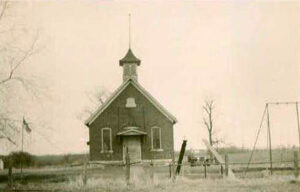
Barker School District No. 20 was disorganized in 1959 and was absorbed into Lecompton School District No. 36. The building was sold and removed from the site.

The old Deer Creek School closed in 1961. A basket dinner and reunion was held on the last day of school, with 180 people attending.
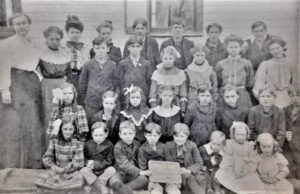
Students at Hopewell School. The school closed in February 1950 and consolidated with Spring Creek No. 2, Clearfield No. 58, and Independence No. 76 to form Baldwin District 92.

Stoney Point School was consolidated with Coal Creek School, Vinland School, and Harmony School to form the new Vinland School District No. 88 in April 1947.
The building and equipment were then sold at auction, and the building was dismantled and removed from the site.
©Kathy Alexander/Legends of Kansas, updated December 2023.
Also See:
Extinct Towns of Douglas County
One-Room, Country, & Historic Schools of Kansas
Sources:
Clio
Douglas County Rural Schools
Kansas Historic Resources Inventory
Kansas State Historical Society, The Columbian History of Education in Kansas, Hamilton Printing Company, 1893
Kenneth Spencer Research Library, University of Kansas
KsGenWeb
Lawrence Business Magazine


